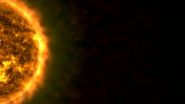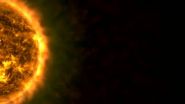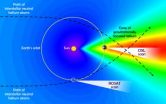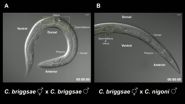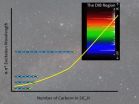(Press-News.org) VIDEO:
This animation illustrates solar wind charge exchange in action. An atom of interstellar helium (blue) collides with a solar wind ion (red), losing one of its electrons (yellow) to the...
Click here for more information.
New findings from a NASA-funded instrument have resolved a decades-old puzzle about a fog of low-energy X-rays observed over the entire sky. Thanks to refurbished detectors first flown on a NASA sounding rocket in the 1970s, astronomers have now confirmed the long-held suspicion that much of this glow stems from a region of million-degree interstellar plasma known as the local hot bubble, or LHB.
At the same time, the study also establishes upper limits on the amount of low-energy, or soft, X-rays produced within our planetary system by the solar wind, a gusty outflow of charged particles emanating from the sun.
"Interactions between the solar wind and neutral atoms in comets, the outer atmospheres of planets, and even interstellar gas produce soft X-rays," explained team member Steve Snowden, an astrophysicist at NASA's Goddard Space Flight Center in Greenbelt, Maryland. "We need to account for these processes because the X-rays they produce complicate our observations of the wider universe."
Decades of mapping the sky in X-rays with energies around 250 electron volts -- about 100 times the energy of visible light -- revealed strong emission precisely where it shouldn't be. This glow, known as the soft X-ray diffuse background, is surprisingly bright in the gas-rich central plane of our galaxy, where it should be strongly absorbed. This suggested the background was a local phenomenon, arising from a bubble of hot gas extending out a few hundred light-years from the solar system in all directions. Improved measurements also made it increasingly clear that the sun resides in a region where interstellar gas is unusually sparse. Taken together, the evidence suggests our solar system is moving through a region that may have been blasted clear by one or more supernova explosions during the past 20 million years.
In the 1990s, a six-month all-sky survey by the German X-ray observatory ROSAT provided improved maps of the diffuse background, but it also revealed that comets were an unexpected source of soft X-rays. As scientists began to understand this process, called solar wind charge exchange, they realized it could occur anywhere neutral atoms interacted with solar wind ions.
Within the last decade, some scientists have been challenging the LHB interpretation, suggesting that much of the soft X-ray diffuse background is a result of charge exchange," said F. Scott Porter, a Goddard astrophysicist also participating in the study. "The only way to check is to design an instrument and make measurements."
Led by Massimiliano Galeazzi, a professor of physics at the University of Miami in Coral Gables, Florida, an international collaboration developed a mission to do just that. The team includes scientists from NASA, the University of Wisconsin -- Madison, the University of Michigan at Ann Arbor, the University of Kansas at Lawrence, Johns Hopkins University in Baltimore, Maryland, the French National Center for Scientific Research (CNRS), headquartered in Paris, and other institutions.
Galeazzi and his colleagues rebuilt, tested, calibrated, and adapted X-ray detectors originally designed by the University of Wisconsin and flown on sounding rockets in the 1970s. Components from another instrument flown on space shuttle Endeavour in 1993 also were given new life. The mission was named DXL, for Diffuse X-ray emission from the Local Galaxy.
On Dec. 12, 2012, DXL launched from White Sands Missile Range in New Mexico atop a NASA Black Brant IX sounding rocket, reaching a peak altitude of 160 miles (258 km) and spending five minutes above Earth's atmosphere. The mission design allowed the instrument to observe a worst-case scenario involving charge exchange with interstellar gas.
The solar system is currently passing through a small cloud of cold interstellar gas as it moves through the galaxy. The cloud's neutral hydrogen and helium atoms stream through the planetary system at about 56,000 mph (90,000 km/h). While hydrogen atoms quickly ionize and respond to numerous forces, the helium atoms travel paths largely governed by the sun's gravity. This creates a "helium focusing cone" downstream from the sun that crosses Earth's orbit and is located high in the sky near midnight in early December.
"This helium focusing creates a region with a much greater density of neutral atoms and a correspondingly enhanced charge exchange rate," Snowden said.
The solar wind is accelerated in the sun's corona, the hottest part of its atmosphere, so its atoms have been ionized -- stripped of many of their electrons. When a neutral atom collides with a solar wind ion, one of its electrons often jumps to the charged particle. Once captured by the ion, the electron briefly remains in an excited state, then emits a soft X-ray and settles down at a lower energy. This is solar wind charge exchange in action.
To establish a baseline for the soft X-ray background, the researchers used data captured by the ROSAT mission in September 1990 in a direction looking along, rather than into, the helium focusing cone. The results, published online in the journal Nature on July 27, indicate that only about 40 percent of the soft X-ray background originates within the solar system.
"We now know that the emission comes from both sources but is dominated by the local hot bubble," said Galeazzi. "This is a significant discovery. Specifically, the existence or nonexistence of the local bubble affects our understanding of the area of the galaxy close to the sun, and can, therefore, be used as a foundation for future models of the galaxy structure."
Galeazzi and his collaborators are already planning the next flight of DXL, which will include additional instruments to better characterize the emission. The launch is currently planned for December 2015.
"The DXL team is an extraordinary example of cross-disciplinary science, bringing together astrophysicists, planetary scientists, and heliophysicists," added Porter. "It's unusual but very rewarding when scientists with such diverse interests come together to produce such groundbreaking results."
INFORMATION:
NASA-funded X-ray instrument settles interstellar debate
2014-07-29
ELSE PRESS RELEASES FROM THIS DATE:
Revolutionary microshutter technology hurdles significant challenges
2014-07-29
NASA technologists have hurdled a number of significant technological challenges in their quest to improve an already revolutionary observing technology originally created for the James Webb Space Telescope.
The team, led by Principal Investigator Harvey Moseley, a scientist at NASA's Goddard Space Flight Center in Greenbelt, Maryland, has demonstrated that electrostatically actuated microshutter arrays — that is, those activated by applying an specific voltage — are as functional as the current technology's magnetically activated arrays. This advance makes them a highly ...
Study: Contrary to image, city politicians do adapt to voters
2014-07-29
Political scientists have long wondered whether city governments in the U.S. are really responsive to their voters. Aren't local governments simply mired in machine politics, or under the sway of local big-money interests? Does ideology matter?
Now a uniquely comprehensive study co-authored by an MIT political scientist has produced a pair of distinctive findings: first, that the policies of city governments do closely match the politics of their citizens, and second, that this occurs regardless of the exact form of government than a city has.
That means that urban ...
Short sellers not to blame for 2008 financial crisis, study finds
2014-07-29
BUFFALO, N.Y. – Contrary to widespread media reports, the collapse of several financial firms during the 2008 economic crisis was not triggered by unsettled stock trades, according to new research from the University at Buffalo School of Management.
The study, forthcoming in the Journal of Financial Economics, analyzed the open interest of fails-to-deliver — stock trades in which shares are not delivered within the three-day trading cycle — in the days before and after the stock crashes of American Insurance Group, Bear Stearns, Lehman Brothers and Merrill Lynch.
The ...
Informal child care significantly impacts rural economies, MU study finds
2014-07-29
COLUMBIA, Mo. – The child care industry has grown significantly in recent years, contributing considerably to the national economy through job creation and increased opportunities for parents to work. However, little knowledge exists of the size and economic impact of child care, especially informal child care, on rural economies. Now, University of Missouri researchers have studied the child care sector in Kansas, particularly in rural areas, and have found that informal child care services create a large economic impact in the state.
Tom Johnson, a professor in the ...
Malaria vaccine shows continued protection during 18 months of follow-up
2014-07-29
A vaccine previously shown to reduce malaria in young infants and children reduces larger numbers of malaria cases in areas of higher malaria transmission, according to results from an ongoing clinical trial published in PLOS Medicine. The effect of vaccination diminished over time, but protection against clinical malaria remained evident 18 months after vaccination.
In the new report, the RTS,S Clinical Trials Partnership* update estimates of vaccine efficacy (the reduction in the risk of malaria in participants who received the vaccine compared to those who received ...
Small increases in Ugandan urbanicity tied to CVD risk factors
2014-07-29
Urban dwellers tend to have higher risk for cardiovascular diseases than people living in more rural locations. In a new study published in PLOS Medicine, Johanna Riha and colleagues, researchers from the University of Cambridge and the MRC/UVRI Research Unit in Uganda, have found that even within rural communities in Uganda that all lacked paved roads and running water, people living in villages with relatively more urban features—such as schools and health facilities –were more likely to have risk factors for cardiovascular diseases such as physical inactivity, lower ...
'Killer sperm' prevents mating between worm species
2014-07-29
VIDEO:
These are time-lapse videos of Caenorhabditis hermaphrodites that were (A) mated with the same species and (B) mated with a different species. Male sperm were fluorescently labeled and appear as...
Click here for more information.
The classic definition of a biological species is the ability to breed within its group, and the inability to breed outside it. For instance, breeding a horse and a donkey may result in a live mule offspring, but mules are nearly always sterile ...
Urbanization of rural Africa associated with increased risk of heart disease and diabetes
2014-07-29
The increasing urbanisation of rural areas in sub-Saharan Africa could lead to an explosion in incidences of heart disease and diabetes, according to a new study carried out in Uganda which found that even small changes towards more urban lifestyles was associated with increased risk of cardiovascular and metabolic diseases.
Over 530 million people live in rural areas of sub-Saharan Africa, where rates of cardiovascular and metabolic diseases tend to be much lower than in urban areas. However, many of these areas are becoming increasingly urbanised, with people living ...
Mysterious molecules in space
2014-07-29
WASHINGTON D.C., July 29, 2014 – Over the vast, empty reaches of interstellar space, countless small molecules tumble quietly though the cold vacuum. Forged in the fusion furnaces of ancient stars and ejected into space when those stars exploded, these lonely molecules account for a significant amount of all the carbon, hydrogen, silicon and other atoms in the universe. In fact, some 20 percent of all the carbon in the universe is thought to exist as some form of interstellar molecule.
Many astronomers hypothesize that these interstellar molecules are also responsible ...
This week from AGU: Cell tower rain gauges, lightning channels, North Sea storm surge
2014-07-29
This Week From AGU: Cell phone tower rain gauges, lightning channels, North Sea storm surge
From AGU's blogs: Dropped cell phone calls become rain gauges in West Africa
A shaky cell phone connection during a rainstorm can be an annoying nuisance. But now scientists are showing that these weakened signals can be used to monitor rainfall in West Africa, a technique that could help cities in the region better prepare for floods and combat weather-related diseases, according to a new study accepted for publication in Geophysical Research Letters, a journal of the American ...
